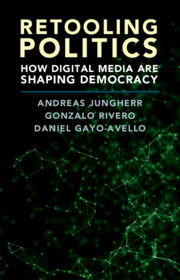Book contents
- Retooling Politics
- Retooling Politics
- Copyright page
- Contents
- Acknowledgments
- 1 The Rise of Digital Media and the Retooling of Politics
- 2 The Flow of Political Information
- 3 Reaching People
- 4 The Effects of Political Information
- 5 Digital Media and Collective Action
- 6 Changing Organizations
- 7 Data in Politics
- 8 Digital Media and Democracy
- 9 Digital Media in Politics
- References
- Index
5 - Digital Media and Collective Action
Published online by Cambridge University Press: 17 June 2020
- Retooling Politics
- Retooling Politics
- Copyright page
- Contents
- Acknowledgments
- 1 The Rise of Digital Media and the Retooling of Politics
- 2 The Flow of Political Information
- 3 Reaching People
- 4 The Effects of Political Information
- 5 Digital Media and Collective Action
- 6 Changing Organizations
- 7 Data in Politics
- 8 Digital Media and Democracy
- 9 Digital Media in Politics
- References
- Index
Summary
Ever since the protest cycle of 2010 and 2011, which included events such as the Arab Spring in North Africa and the Middle East, Occupy Wall Street in the United States, and anti-austerity movements in Spain and Greece, the question of whether digital media are transformative tools that facilitate collective action has been a major theme in the public imagination (Freelon, McIlwain, and Clark 2016). Although the potential of computer-mediated communication for social and political activism has been one of the central topics in the digital politics literature almost from the very beginning (see Margolis and Resnick 2000), with early milestones in the Zapatista movement in 1994 or the Seattle protests against the World Trade Organization (WTO) in 1999 (Kahn and Kellner 2004; Van Laer and Van Aelst 2010), it was in the 2010s, after the popularization of social media, that the public started to think of the internet as another tool in the political repertoire of social movements and not as just a novelty item.
- Type
- Chapter
- Information
- Retooling PoliticsHow Digital Media Are Shaping Democracy, pp. 132 - 157Publisher: Cambridge University PressPrint publication year: 2020



